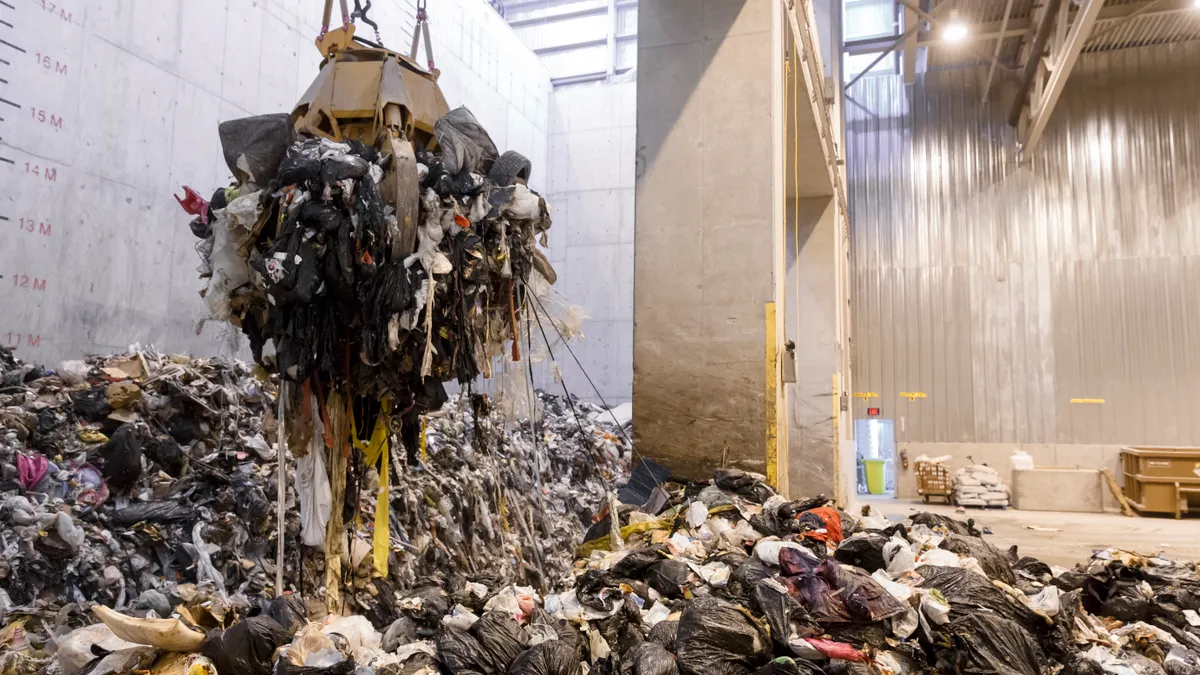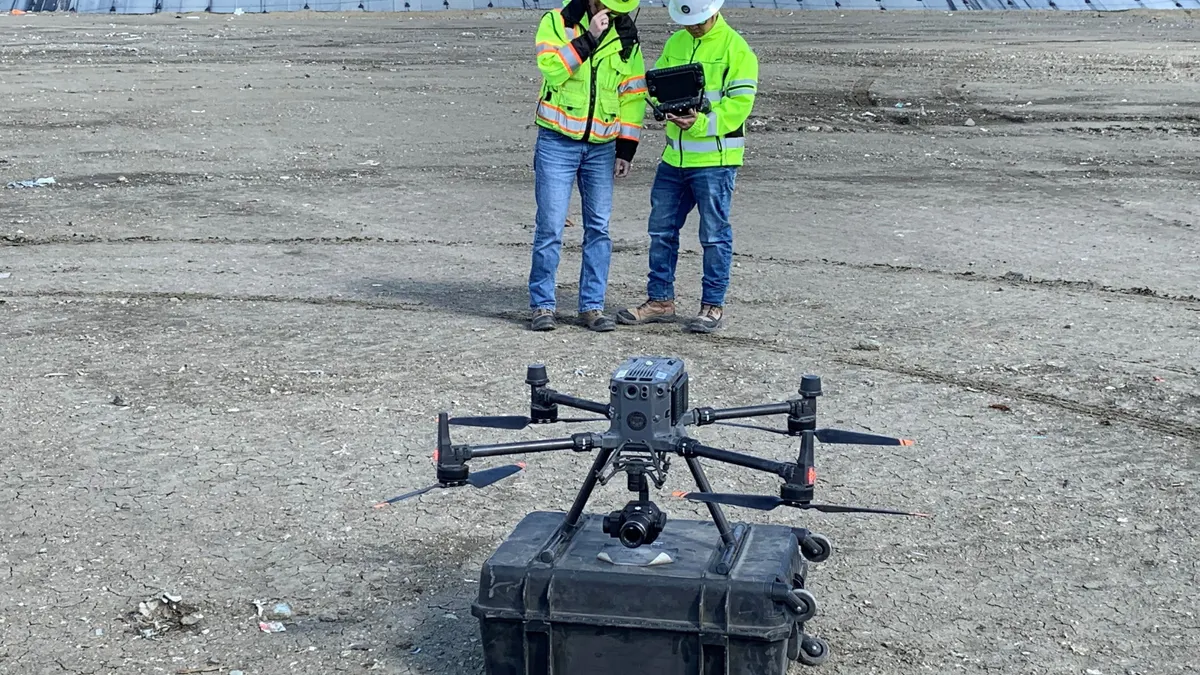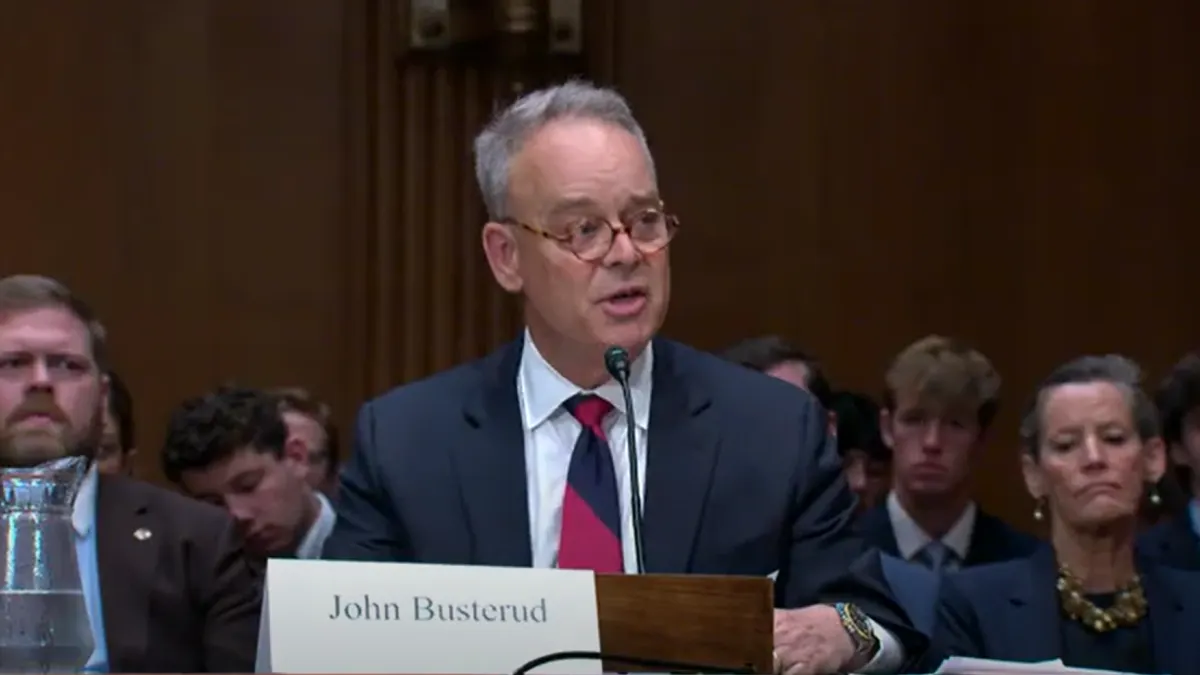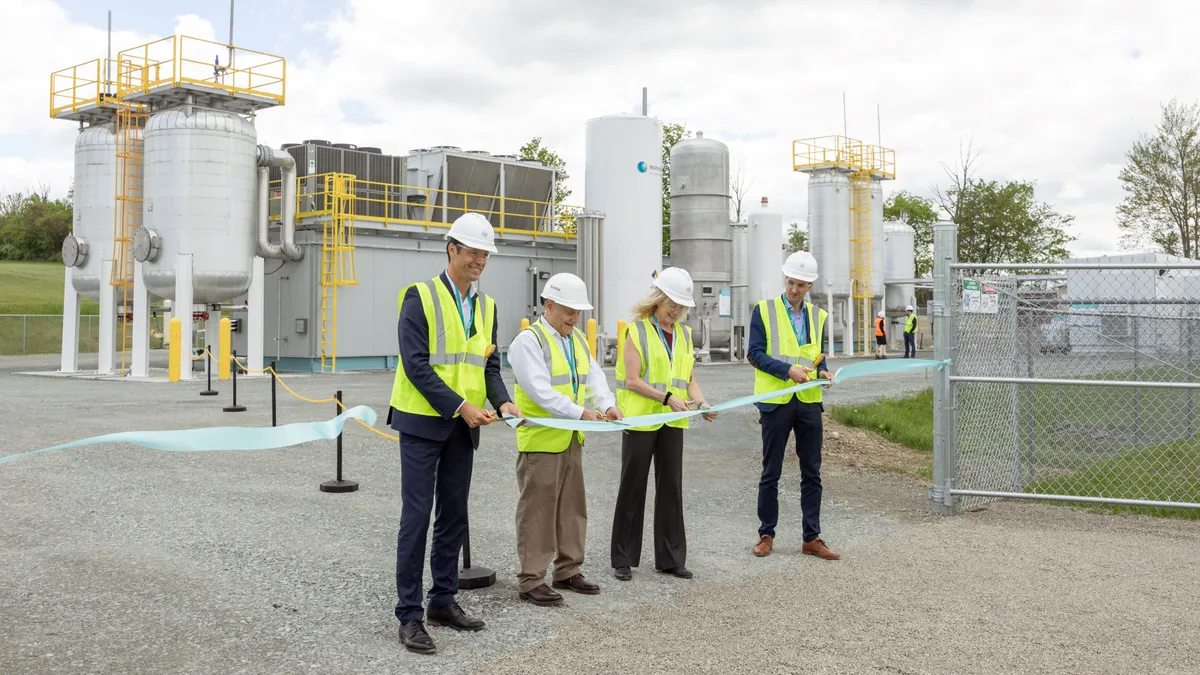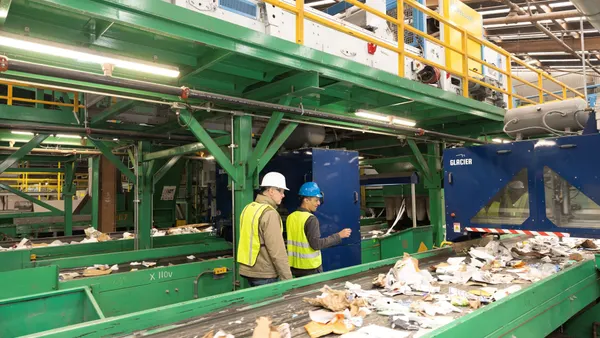It's been a bumpy few months for U.S. incinerators. Growing public concern over WTE's environmental and health effects has prompted concerted community campaigns against local facilities, and the outcomes — the Baltimore Clean Air Act, Detroit Renewable Power's sudden closure in March, ongoing debate about inclusion in renewable energy standards and other state policies — suggest an industry in flux.
Covanta executives, however, expressed new levels of optimism in last month's Q1 earnings call and struck a sanguine tone at the WasteExpo investor summit in Las Vegas, highlighting emerging opportunities in domestic and foreign markets.
"If you think about the world outside the U.S., there's been over 100 WTE facilities built [in the last five years]," said Michael de Castro, executive vice president of supply chain. "We're learning with new projects how to make plants less expensive — lessons that can be carried over to the U.S."
Waste Dive's Rina Li and Cole Rosengren spoke to de Castro as well as Derek Veenhof, executive vice president of asset management, and Dan Mannes, vice president of investor relations, about WTE's prospects in the U.S. versus landfills, regulatory developments, energy pricing trends, emerging technologies and more.
The following conversation has been edited for brevity and annotated for context.
WASTE DIVE: Landfills have obviously long been dominant in the U.S., but a lot of people I've spoken to lately seem very optimistic about WTE's prospects. What's your view of the current competitive landscape in the U.S. as compared to landfills?
DEREK VEENHOF: We have countries around the globe building EfW (energy-from-waste) plants by choice. A lot of that is about dense urban environments saying, 'The landfill side hasn't really worked out. We're not getting the recycling rates we want. Let's get something a bit more technologically long term that's going to solve our issues.' A big part of the push is going to come from that — and it has to be combined with regulation.
MICHAEL DE CASTRO: That's the problem. Energy prices in the U.S. are going to stay low for a long time, and we have to reduce the capital costs associated with our plants — the plants we're building today are $400-600 million dollars. So landfills have a huge capital cost advantage over our assets.
The only way to really address that is opportunities in these markets, where it's very costly to move waste to landfills, or where there's regulatory support or a big initiative around sustainability. Eighty-five percent of the Fortune 500, S&P 500 companies today have sustainability goals, and most of them — more than half — focus on what they're going to do around waste. All the things we're focused on is to meet that need. The relationship that Derek and his team have with those municipalities is critical, because you need a long-term window — to build and permit one of these plants, you're talking five years minimum, probably 7-10 years. It requires thoughtful leaders in these municipalities, and the decision makers have to take that longer-term view.
DAN MANNES: You also have to think about landfill lifespans. As those fill and close, the next spot is that much further away. So a whole cost structure then starts shifting, allowing you to go back and say, 'If we're going to have to spend $100 a ton to move it from here to somewhere else, why wouldn't we want to deploy capital locally, have jobs locally, have tax benefits locally?' Right now, we're moving through a transitory stage around the original big landfills. They're going to run out of air space; they're not there forever.
The landfill industry is quite formidable in terms of lobbying efforts and messaging. Is there a sense that you're going to have to find a new way to make your case to customers?
DE CASTRO: You're seeing more leaders and politicians worrying about the long-term ramifications of what they're doing. The EPA looks at EfW as the only greenhouse gas negative producer of energy — even more so than wind and solar. There are more and more people thinking about sustainability. If we can get to the point where we can recycle 100% of the material that comes into our facilities, that'll go a long way to helping convince more and more politicians to look at this as a solution as opposed to just the energy recovery aspects of it.
There've been a lot of developments in the U.S. regulatory landscape lately, with states like Oregon considering changes to renewable standards and state/local governments like Baltimore upping their emissions standards. What's commanding the majority of Covanta's attention, and what is its strategy for adjusting to these changes?
VEENHOF: We've always had a community outreach strategy that we've deployed for years. So I think when you get to the heart of the couple of cases — Detroit didn't have the greatest technology, so that had its limitations already. But you've got to have a policy of being engaged with communities that you're operating in, and you've got to be able to dialogue, work with people — even the people that say they don't want us here. You've got to bring them into your plant and educate them.
DE CASTRO: A lot of the people out there advocating against EfW aren't using science. We believe that science will prevail, and that will be something that we just have to educate people on more and more. Our emissions at our facilities are some of the lowest in the world. When you compare that to the greenhouse gas impact of landfills — trucks driving the waste to landfills and transfer stations, the actual decomposition of the waste in the landfill — we look much, much better.
Mannes adds that the U.K., multiple EU countries and others exclude WTE as an emitter of greenhouse gases, and many U.S. states include it in their renewable portfolio standards.
As the energy landscape evolves, does it still make sense to think about these plants as being about energy production first? EfW is the preferred acronym now, so that's the message that gets pushed. But do the waste disposal assets come first, with energy as a sort of byproduct?
MANNES: Energy is a secondary revenue stream. If you look at us holistically, we're roughly 70% waste, 23% electricity, 5% metals. All of our revenue matters, but waste matters a lot more. If you look at the economics of maintaining a plant versus divesting, waste price is A, B and C. It's the most important factor, with energy being a secondary factor.
DE CASTRO: That's why the work Derek's team does on profile waste is so important. Just in this last quarter, non-contracted waste pricing was up over 10%, which is tremendous. Again, the work that we're doing in the plants is to give him more capacity to bring in higher-priced waste.
VEENHOF: I look at energy as a free option at this price ... right now, we're at a point where a lot of natural gas is available and it looks like it's going to stay, but there could be any number of different drivers that change that. So you try to optimize while you're in that space.
Veenhof highlights ongoing projects in Syracuse, New York and Camden, New Jersey seeking to establish a microgrid with WTE facilities as anchor power generators.
So there's a lot of new opportunities coming out of this disruption in the energy space, and the disruption is really caused by low natural gas, plus wind and solar coming on.
Landfills are also pushing the energy narrative from gas capture these days. How would you respond to that? Do you still believe your energy story is more favorable than theirs?
DE CASTRO: Oh, without a doubt. Without a doubt.
Ask them a simple question — 'what's your megawatt hours per ton processed?' — and you'll get the answer. They're generating so little energy … And now they're running into other issues. [Companies have] mentioned the issue with biosolids, the challenges that creates with landfill operation, leachate. So it's positive — it helps generate higher methane — but it's also odor-causing and creates other challenges and stability issues in the landfill. So that's something they'll have to manage.
VEENHOF: Thermal treatment definitely has its place. Drugs, PFOAs — you can treat those through thermal treatment. It's what do you with the residual energy — we can do a lot with that. Ash — we can do that. All that unrecyclable metal that ended up in the waste — we're doing that, too.
DE CASTRO: Just ask yourself a simple question: why is China looking into developing hundreds of these plants? They have a lot more land than we have here. If it really was about cost, they'd landfill it — but they realize the long-term environmental impacts are more negative, so there's a government mandate to address these issues. That could happen here — it depends on when that awakening occurs. But we'll be ready.
VEENHOF: That might not ever happen in the U.S., right? But if you look at Covanta's environmental solutions space, which is one of the big growth lines for our business — where we have manufacturers that have a corporate mandate, these are global companies.
DE CASTRO: J&J, P&G, SC Johnson — they're not sending their material to landfills. One is the certified destruction piece, but they also don't want the long-term liability.
VEENHOF: So I think the pathway here is going to be much longer, but I think it will come. And there might be other things that get invented along the way — there might be source separation of different material streams. Maybe we can make some of that work economically.
DE CASTRO: We're constantly looking around the world — that's how we found the technology that we're using for our ash reuse. There are people that have technology at a pilot scale where they can convert parts of the waste stream into a fuel. If that can be economic at a commercial scale, it's going to have a huge impact.
Is that viewed as competition? This year alone we've — and I know they're very different — Fiberight, RePower South, BioHiTech Global all open new facilities.
DE CASTRO: Fiberight came to us to help them operate their facilities. So we see that as opportunity.
So anything that's not landfill is perhaps helpful for your narrative, so to speak.
DE CASTRO: We're the biggest in the world, and we also have the most complicated technology. China Everbright is No. 2, and they only have two different types of technology. We have 14 different types of technology. So if anybody has the technical operations maintenance capability to do any of those other technologies at scale, Covanta is in that place. If Fiberight is successful, it becomes a [potential] acquisition target for us. We have everything it takes to make that business successful and scalable over time.
VEENHOF: From my perspective, those are commodity plays, right? We were well on our way to building an advanced recovery plant a few years ago in Indianapolis — it was going to sit on the front end of our plant. You didn't have to change the truck routes, you didn't have to do anything — it just sat right there. So if those markets become available and are economical, we're looking at it and saying, "Who's going to be the disruptor? How are they better with that than we are over here? Can we attach it? Can we do a bolt-on?" Because our infrastructure is in really good locations. So far, it doesn't seem like economically our shareholders want us to do that, because the economics don't suggest the payback's there. That might change, and we'll be ready to go.
De Castro and Mannes go on to talk about foreign market potential — particularly China and Southeast Asian countries — emphasizing economic viability as Covanta's primary consideration with regard to pursuing opportunities.
Climate change isn't coming up as often as some feel it perhaps ought to in the waste world these days. What are the risks and opportunities for Covanta as related to the climate crisis?
Veenhof and de Castro cite potentially vulnerable plants in floodplains — Delaware Valley, Pennsylvania; Long Island, New York; and Essex, New Jersey.
VEENHOF: We had an issue in Essex where we had five feet of water in the base of the plant. So we made a lot of physical changes in that plant after Hurricane Sandy — pumps, motors, control room. We've elevated. So where we think we're at risk, we're making some moves — at least on the more valuable projects.
DE CASTRO: We have a number of projects in the next three years that are focused on reducing our NOx emissions. We've got our two facilities in Virginia and a facility in California. So we're very focused on climate change and what the impacts will be, and we believe that we can more than adequately address them going forward. We agree with you: we think it will become a bigger issue, and that we need to be aware of it and be prepared to address it.
MANNES: But from our perspective, honestly, it's more of an opportunity than a risk. We're already exempted from the Regional Greenhouse Gas Initiative, which is pretty much the entire Northeast. When the federal government doesn't act, states do. More progressive states — California, New York, Massachusetts, etc. — will push forward on their own, and we're a net beneficiary from those in the same way that EfW is a beneficiary in Europe as well. So we actually look at it from a positive standpoint — it could be yet another driver for more EFW capacity in time.



